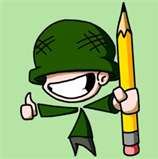Naturally, this "saint" was not recognized the Church, but St. Guinefort was venerated through the end of WWI, and in fact some reverberations of the belief continued through the '60s.
We bridge players often find ourselves praying for a miracle, but instead, we should be polishing our basics...
And that brings us to the Dreaded Reverse. Why do Reverses cause so much trouble? Maybe they can't see through the disguise. A reverse can quickly be identified because a) it is a two-level rebid IN A SUIT RESPONDER BYPASSED, and b) the second named suit is HIGHER RANKING than the first.
A reverse promises a fat intermediate hand or more, and the first named suit MUST BE LONGER than the second named suit. And a Reverse is forcing for one round.
So let's take the disguise off the spinach and see if we would reverse with these hands or not.



